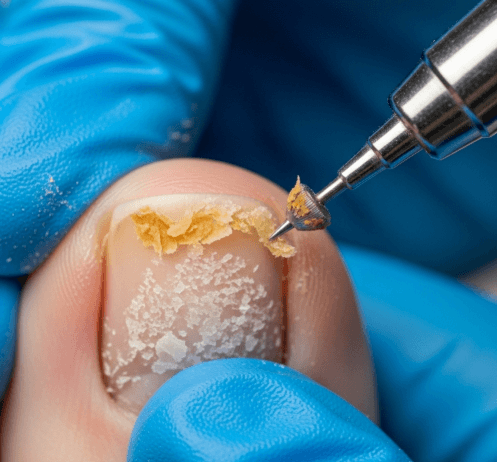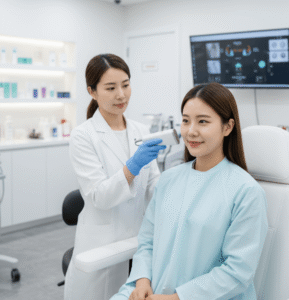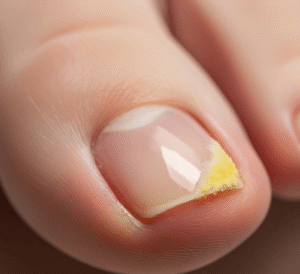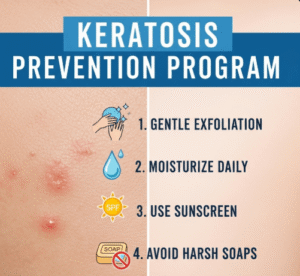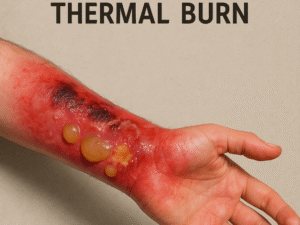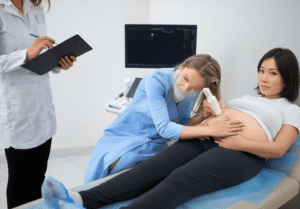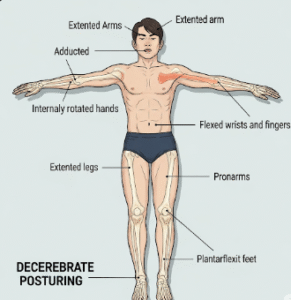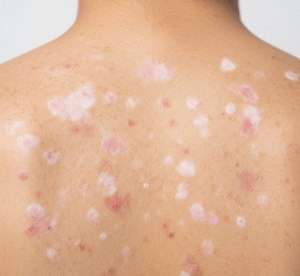What it is
Nail plate debridement in Korea is a therapeutic podiatric or dermatological procedure where thickened, damaged, or infected portions of the nail plate are carefully reduced or removed.
It is not a full nail removal, but rather a controlled thinning and trimming of diseased nail material to improve comfort, reduce fungal load, and enhance the effectiveness of topical or oral treatments.
→ In Korea, nail debridement is commonly performed in dermatology clinics, podiatry centers, and medical foot care units.
• Frequently used in cases of onychomycosis (fungal nail infection), nail psoriasis, trauma-related thickening, or elderly nail care.
• Considered a non-invasive, conservative treatment, often part of a larger management plan.
Why it’s done
Patients in Korea undergo nail plate debridement for:
→ Pain relief → Thickened nails can press on the nail bed or surrounding skin.
→ Functional improvement → Helps patients walk more comfortably in shoes.
→ Cosmetic reasons → Improves nail appearance by reducing thickness and discoloration.
→ Treatment support → Enhances penetration of topical antifungal medications.
→ Preventive care → Reduces risk of ulceration in diabetic or elderly patients.
Alternatives
Other management options for nail disorders include:
• Oral antifungal medications → Terbinafine or itraconazole for fungal infections.
• Topical antifungal lacquers → Ciclopirox, efinaconazole, or amorolfine.
• Laser therapy → Targets fungal organisms without removing nail tissue.
• Total nail avulsion → For severe, resistant nail disease.
• Routine foot care → Filing and trimming at home for mild thickening.
→ Debridement is preferred when a quick reduction in thickness or fungal load is needed.
Preparation
Before nail plate debridement in Korea, preparation includes:
- Clinical evaluation → Dermatologist or podiatrist examines nail thickness, discoloration, and infection signs.
- Diagnosis confirmation → Fungal culture or biopsy may be performed to confirm onychomycosis.
- Medical history → Review of diabetes, circulation issues, or immune disorders.
- Patient education → Explanation of the procedure, expected results, and ongoing care needs.
→ Korean clinics often use digital imaging and fungal testing to track nail improvement.
How it’s done
Nail plate debridement in Korea is performed step by step:
- Cleansing → The affected nail is disinfected.
- Trimming and thinning → Thickened nail areas are trimmed using sterilized nail nippers, rotary burrs, or podiatric drills.
- Debridement of diseased portions → Removal of loose, discolored, or brittle sections of the nail plate.
- Smoothing → The nail surface is filed or polished to improve cosmetic appearance.
- Adjunctive treatment → Antifungal solutions or medicated creams may be applied post-debridement.
→ The procedure usually takes 15–30 minutes per session, depending on severity.
→ Often repeated every 4–8 weeks as part of ongoing nail care.
Recovery
Recovery after nail plate debridement is simple and requires minimal downtime:
• Immediate relief → Pressure and discomfort from thick nails are reduced instantly.
• Cosmetic improvement → Nails look thinner and healthier after trimming.
• Daily care → Patients are advised to keep nails clean, dry, and apply prescribed antifungal agents.
• Follow-up care → Repeat sessions may be necessary until normal nail regrowth occurs.
→ Most patients resume walking and normal activities immediately.
Complication
Although generally safe, possible risks include:
- Mild bleeding → If the nail is trimmed too close to the nail bed.
- Temporary tenderness → Especially if large sections are reduced.
- Infection risk → Very rare if performed in sterile clinical settings.
- Nail deformity → Possible if repeated aggressive debridement is performed.
→ In Korea, complications are rare due to precision tools and professional podiatric expertise.
Treatment option in Korea
Korea offers advanced and patient-friendly nail plate debridement services:
→ Dermatology clinics and podiatry centers → Equipped with modern rotary devices and sterile instruments.
→ Integration with antifungal therapy → Debridement is usually paired with oral, topical, or laser antifungal treatments.
• High cosmetic standards → Korean clinics prioritize not just function but also the nail’s aesthetic outcome.
• Special care for diabetics → Foot clinics provide safe debridement to prevent ulcers or complications.
• Medical tourism → Many patients visit Korea for integrated nail care programs combining medical treatment with cosmetic refinement.
→ With its precise technique, holistic care, and focus on both health and beauty, nail plate debridement in Korea provides effective relief, improved nail appearance, and enhanced treatment outcomes.

